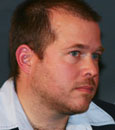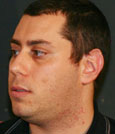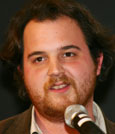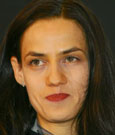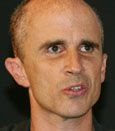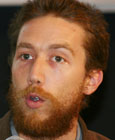| What's New at the Center for Future Civic Media? | ||||||
|
MIT Center for Future Civic Media Director Chris Csikszentmihalyi presents the Center's most recent projects. From community mapping to news tracking, from collective action to rural empowerment, from cultural mixing to carbon consciousness, civic media is any technology or technique that strengthens a geographic community. Civic media researchers will demonstrate their projects in a lightning-round format, with time for discussion and questions following each presentation listed below. Making Change Rethinking News An audio recording of What's New at Center for Future Civic Media? is now available. NOTE: This event relied heavily on visual presentations which are, of course, not available on the audio recording. A complete video will be posted as well as a text summary. Video of What's New at Center for Future Civic Media? is now available. [this is an edited summary, not a verbatim transcript] This Forum showcased the team of researchers in the MIT Center for Future Civic Media, a collaboration of MIT’s Comparative Media Studies and the Media Lab.
Center Director Chris Csikszentmihalyi defined civic media as that which strengthens and empowers communities and he was followed by a rapid-fire series of short project presentations making heavy use of PowerPoint and live web. The following is a sampling of projects currently under way at the Center: The first group of projects focused on fostering the connections between members of a community. One of these was the aptly named Comm.unity project presented by Nadav Aharony (video clip).
Comm.unity is a platform that enables developers to create socially aware, peer-to-peer applications that enhance proximity-based communications. Some of the things that make Comm.unity appealing are that it is easy for developers to use because it requires no networking knowledge or different versions for different devices. One of the tools offered on the Comm.unity platform is SnapNshare, which allows people to create, tag and share content automatically with those nearby. Aharony described it as “a proximity-based Twitter that lives off the grid”; an application that virally transmits information to those close to the publisher. Another interesting project in the group was SourceMap, presented by Matthew Hockenberry (video clip).
This is an application that answers complicated questions about where the goods and services we buy and consumer come from and their impact globally and locally. This project is essentially an open view into the supply chain whose goal is to make product sources transparent. As a practical example, Hockenberry showed a SourceMap for the various breweries in the Scottish Highlands. At one point, while beer was brewed in Scotland it was transported to Northern England for bottling. Eventually, beer brewed locally was able to be bottled in a more central location – positively impacting the costs associated with production. The next set of presentations dealt with news and information and how it is packaged and shared.
Florence Gallez, who presented OpenPark, started by describing the current state of the news industry (video clip). While there are many issues – including quality, ethics and press freedoms – a very important problem is collaboration. To help foster collaboration, Gallez created OpenPark – an open source toolbox for reporting. Using OpenPark, stories can be covered from multiple angles and be contributed to by multiple sources. Lostinboston, a project by Rick Borovoy, addresses mapping and directional issues in urban environments (video clip). Starting in Boston, where poor signage is said to have started with colonists removing street signs to stymie the British, Borovoy hopes to inspire communities to reclaim their streets, or at least their sense of place and direction.
The first sign was placed on property belonging to the Massachusetts College of Art on Huntington Avenue. It was placed to clarify and guide people along Boston's “Avenue of the Arts,” a designation for that part of Huntington Avenue near the Museum of Fine Arts. Using ideas and input from the community, Lostinboston placed the sign on a private portion of the sidewalk and did so in a matter of months rather than the years typical for placing municipal signage. Josh Levinger presented VirtualGaza (video clip), a community mapping/news project for the occupied territories which began in 2008 just as war was breaking out between Israel and the Palestinians. Its goal was and is to aggregate the stories of people living in the war zone. Because the Israelis had imposed a media blackout there was no other way to bring these stories to the world. Levinger combined mapping data with information provided by people on the ground to put a human face on the destruction taking place. VirtualGaza provided not only a news channel to the world but also functioned as an internal resource for people living in the war zone to stay in touch and understand what was happening in other parts of the territory. The final set of projects dealt with creating connections between different communities. Charlie DeTar presented BetweenTheBars (video clip). This project is a blogging platform for the country's huge prison population (one in every 142 Americans, according to DeTar). Clearly, the isolation of incarceration makes maintaining connections to the community difficult and the absence of those connections makes life in and out of prison more difficult.
BetweenTheBars is a paper-and-pencil based system that allows prisoners to maintain their connection to the community through blogging. Prisoners provide their posts in written form and – using a crowd sourcing model – they are transcribed and posted. Comments to prisoners' posts are likewise provided in printed form. Like many of the projects described, BetweenTheBars is in its early stages of development. To learn more about past and current projects visit the Center's website at http://civic.mit.edu. | ||||||

